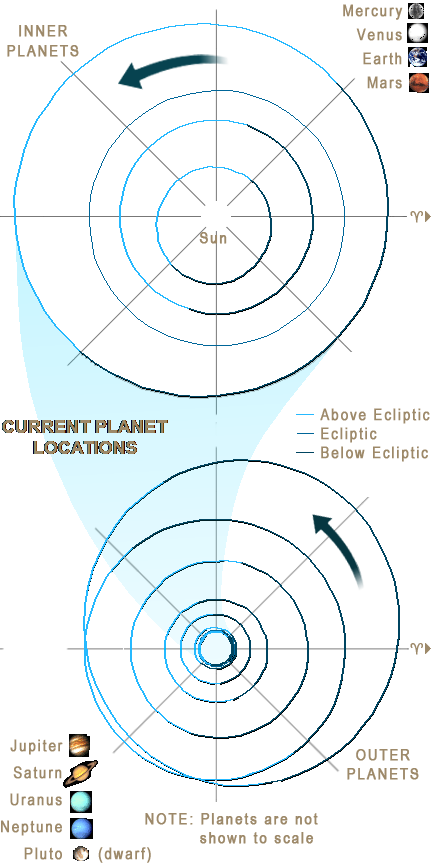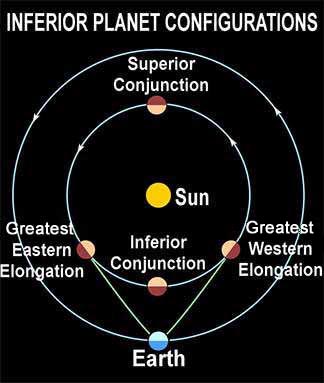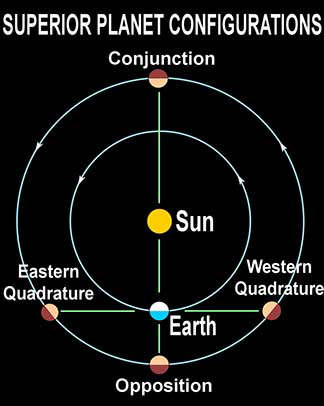



CURRENT PLANETS VIEWED FROM EARTH
Apparent Sizes, Phases, Distances & Orbital Positions
Planet Image Credits: NASA/JPL Solar System Simulator developed by: David Seal
Click on planet images for additional current views and Skypaths of 2024.
FOV of Planet Images: 1.125' (arc-min) Magnification of Planet Images: 766x
SEARCHING SKY FOR PLANETS . . . 
Click on orbital images below for larger views.
Courtesy: Fourmilab Switzerland

Inner Planets in 3-D Full Solar System in 3-D
Are you observing the sky with a telescope or binoculars tonight? This page will show you what to ex- pect when you train your instruments skyward. Here you see how large the planets currently look in relation to one another and—as a bonus—their distances from Earth! Moreover, you can click on any of these celestial wanderers (including dwarf-planet Pluto) to open more revealing views of it, the positions of its major moons, as well as the body's current position above Earth's surface!
In addition, you've no doubt noticed that two views from "above" the Solar System are nestled among NASA's simulated telescopic views of the Inner and Outer Planets and Pluto. These show the present orbital positions of the eight major planets and Pluto, keeping you apprised of our Solar System's current overall circumstances. The view from above the Inner Planets can be especially useful when observing Mercury and Venus, as it reveals whether each is currently nearer or farther than the Sun. Both Solar System views can also help you predict which planets currently appear to be growing or shrinking in our skies! This can be important if you plan multiple-night viewing of the planets with orbits closer in size to Earth's orbit. These, of course, change in apparent size more rapidly and to a larger degree than the planets with considerably larger orbits.
The two Solar System views above also give a sense of how close a planet may be to achieving its various possible orbital configurations ![]()
![]() with Earth. You can confirm the dates and times of these configurations with this Calendar of Astronomical Events. The two diagrams below show the various forms these orbital "arrangements" can take. And this awesome Planetary Configurations Simulator lets you set the heavens in motion for added insights.
with Earth. You can confirm the dates and times of these configurations with this Calendar of Astronomical Events. The two diagrams below show the various forms these orbital "arrangements" can take. And this awesome Planetary Configurations Simulator lets you set the heavens in motion for added insights.


For the current year don't forget that you may view its Best Planet Conjunctions, as well as the elonga- tions of Mercury and Venus and—collectively—of all the Major Sky Objects. In addition, check out the Skypaths of the Planets! Now it is easy keep constant tabs on the major bodies of the Solar System! So return to this page again and again. You will soon discover how much it can enrich your sky viewing.
Note that the Sun and the Moon, which look roughly the same size from Earth, appear much larger than the planets in our earthly skies! In fact, at the same scale as the planets above, the solar and lunar disks would need to be displayed on the order of 15,000 pixels in diameter! This is many times the size of your computer screen! The edge of the Moon is shown at left at roughly that scale, and the table below com- pares the minimum and maximum apparent sizes (in arc-minutes) of the Sun, the Moon and the planets.
APPARENT SIZE
AVERAGE
APPARENT SIZE
OF THE MOON
(at same scale as
planet views above)
| BODY | MINIMUM | MAXIMUM |
|---|---|---|
| Sun | 31.45' | 32.53' |
| Moon | 29.43' | 33.54' |
| Mercury | 0.075' | 0.217' |
| Venus | 0.162' | 1.100' |
| Mars | 0.058' | 0.418' |
| Jupiter | 0.497' | 0.835' |
| Saturn | 0.242' | 0.335 |
| Uranus | 0.055' | 0.068' |
| Neptune | 0.037' | 0.040' |
The table reveals that Venus can appear larger in our skies than any other planet! And yet—when it looks largest—it has a diameter which is only about 1/30th (one thirtieth) of those of the Sun and Moon! Mars is the planet with the largest variation in apparent size! When Mars looks its largest, its diameter appears over seven times larger than when it looks its smallest! Naturally the Inner Planets exhibit the greatest variations in apparent size. This is because their orbits are nearest to Earth's own orbit. Other fascinating facts may occur to you when you compare the figures in the table to the views above.
Also check out the Current Moon Phase, the Moon's Current Orbital Position, Phase & Distance and the intriguing Current "Relative" Apparent Sizes of the Sun and the Moon.
Simulator Image Notes: 1) Fields of View are measured horizontally. 2) Each planet is shown with its local north "upward"
in its view, i.e. in the "12:00 midnight" direction. This is the only way that the NASA/JPL simulator shows distance to Earth.
3) Light-Travel Time is not included in calculated times. 4) Eclipse shadows of planet moons are not displayed.
Home Intro News Gallery Sky-Gifts Bonuses Tips
Learning Ctr Help Links Credits Legal Contact Us
© 2007-
by Gary M. Winter. All rights reserved.
Interested in political cartoons and humor?
Check out The HIPPLOMATS™.
SkyMarvels, Sky Marvels, SkyMarvels.com, CURRENT RELATIVE APPARENT SIZES OF THE PLANETS FROM EARTH. Planets' Current Phases, Planets' Current Distances, Planets' Current Apparent Sizes,, celestiaforall, CELESTIA, astronomy, space, simulations, animations, downloadable astronomy posters, stars, planets, Inner Planets, Outer Planets, Inferior Planets, Superior Planets, moons, asteroids, comets, Oort Cloud, galaxy, galaxies, Milky Way, Andromeda, globular clusters, binaries, quasars, black holes, supermassive black holes, telescope, telescopes, planetarium, software, freestuff, satellites, add-ons, addons, scripts, eclipses, Solar Eclipses, Lunar Eclipses, Solar Eclipse Finder, Lunar Eclipse Finder, mutual eclipses, transits, occultations, Solar System, CELES-TOOLS, celeSTARrium, CELX, CELX programming, Freebies, multiple views, atronomical unit, light year, parsec, meteors, meteor showers, Perseids, Geminids, Leonids, barycenter, time, Time Zones, tides, alignments, conjunctions, oppositions, seasons, apogees, perigees, aphelion, perihelion, Earth, Luna, Mercury, Venus, Mars, Jupiter, Galilean Moons, Io, Europa, Ganymede, Callisto, Saturn, Titan, rings, Uranus, Neptune, Triton, E-MSpectrum, electromagnetic spectrum, astronaut, equinoxes, solstices, precession, rotation, spin, inclination, tilt, Ecliptic, orbits, ellipse, parabola, hyperbola